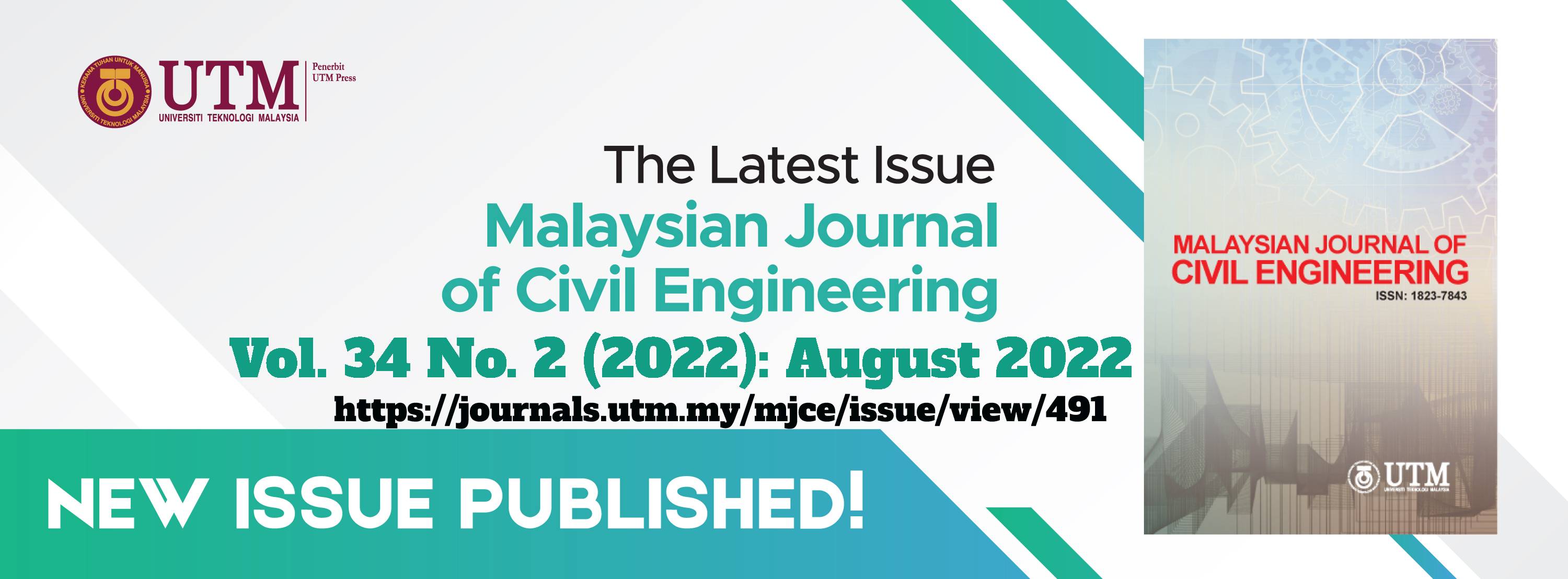THE FIRE RESISTANCE OF CONCRETE MADE WITH RECYCLED PLASTIC AS PARTIAL REPLACEMENT FOR COARSE AGGREGATE
DOI:
https://doi.org/10.11113/mjce.v34.18309Keywords:
Recycled Plastic Aggregate (RPA), Polyethylene Terephthalate (PET), Fire hazard, Coarse aggregate, Lightweight concrete.Abstract
This research is aimed to investigate the fire resistance of recycled discarded plastic when used as partial replacement for normal granite coarse aggregate in concrete when exposed to elevated temperatures. Discarded Polyethylene Terephthalate (PET) bottles were cut into a maximum size of 20mm to produce Recycled Plastic Aggregate (RPA). The replacement of normal aggregates with RPA were in proportion of 0%, 5%, 10%, 15%, 20%, 25% and 30% by weight of normal coarse aggregate. The compressive performance of the concrete made with RPA were studied by casting three 100 mm cubes for each of the percentage replacements and tested at 7, 14 and 28 days of curing age. A set of three (3) concrete cubes for each percentage replacement was cured for 28 days and subjected to a temperature of 718oC for a duration of 15 minutes in a furnace. Results of slump tests on fresh concrete showed that workability decreased with increase in RPA. Densities and compressive strengths for normal cube samples not subjected to elevated temperatures and the sample subjected to temperature of 718oC increased with increase in curing age and decreased with increase in percentage of RPA. The result showed that the concrete specimen with 10% replacement of RPA was optimum for good thermal stability.
References
American Concrete Institute (ACI). 2000. State of the art report on high strength concrete. ACI 363R - 92, Detroit. ACI 211.4R – 93
American Concrete Institute (ACI 213). 2001. Guide for Structural Lightweight-Aggregate Concrete. ACI 363R - 92, Detroit. ACI 213R – 14
ASTM E119. Fire Tests of Building Construction Materials.
Anand, P.B. 2016. Waste management in Madras revisited. Environmental Urbanization, 11(20): 161-176.
Bamigboye, G., Ngene, B., Aladesuru, O., & Mark, O. 2019. Thermal Effects of Treated and Untreated Coconut Fibre (cocos Nucifera) Reinforced Concrete at Varying Temperatures
BS 1881-111. 1983. Method of Normal Curing of Test Specimens. British Standard BSI Group Headquarters 389 Ciswick High Road, London.
BS 812-103.1. 1985. Methods for determination of particle size Distribution section 103.1 sieve tests. British Standard BSI Group Headquarters 389 Ciswick High Road, London, W 4 4Al, UK. Standards Policy and Strategy Committee
BS 882 1992. Specification for Aggregates from Natural Sources for Concrete. British Standard BSI Group Headquarters 389 Ciswick High Road, London, W4 4Al, UK. Standards Policy and Strategy Committee.
BS EN 12350-2. 2009. Testing Fresh Concrete – Slump Test, British Standards.
BS EN 12390-3. 2009. Standard Test Methods for Compressive Strength of concrete. British Standard BSI Group Headquarters 389 Ciswick High Road, London, W4 4Al, UK, Standards Policy and Strategy Committee
BS EN 197-1. 2000. Methods of Testing Cement Determination of setting time and soundness. British Standard BSI Group Headquarters 389 Ciswick High Road, London, W4 4Al, UK. Standards Policy and Strategy Committee
Gauch, H.G. 2010. Multivanate Analysis in community ecology. Cambridge university Press, 85
ISO 834. 1999. Fire Resistance Tests – Elements of building Construction.
Khaloo, A.R. and Afshari, M. 2004. Flexural behavior of small steel fiber reinforced concrete slabs cement and concrete composites, 27: 141-149
Okafor, F.C. 2016. Rural Development and the Environmental Degradation versus Protection. Environmental Issues and Management in Nigerian Development, 150-163.
Shubham, B., Shreyansh, A., Sachin, S., Taher, B., Sourabh, J., Rishi, K., and Sarvesh, N. 2019. Evaluation of use of plastic waste in construction.
Society of Plastics Industries (SPI), 2000. Different Types of Plastics and Their Classification
Umasabor R.I. and Okovido J.O. 2018. Fire resistance evaluation of rice husk ash concrete. Heliyon 4, 1035.
Wilson U.N., Gambo Z., Mohammed I.S., Eze O.C., Odeyemi O.S. 2021a. Pozzolanic Properties of White Cowpea Husk ash. Journal of Building Materials and Structures. 8: 93-102.
Wilson U.N., Sani J.E., Adefila A.A., Mohammed I.S. 2021b. Thermal Resistance Evaluation of Raffia Palm ash concrete. Journal of Applied Science and Environmental Management. 25(2): 459-465.
















